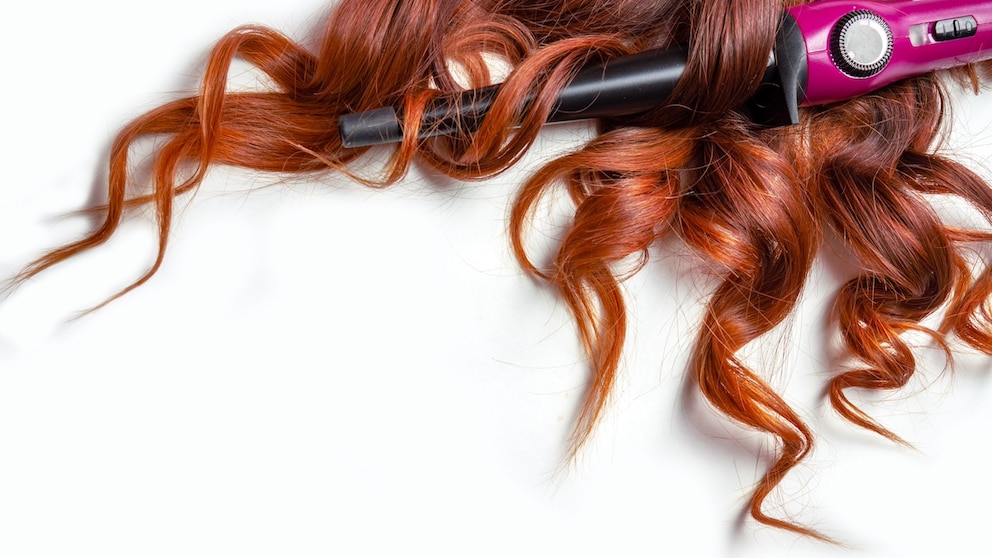October 18, 2024, 3:09 pm | Read time: 4 minutes
Thick, thin, ribbed, made of Teflon, ceramic, or metal – curling irons come in many shapes. But which one is best suited to which needs? Experts provide useful tips.
Overview
Coating
The curling iron should ideally be coated with ceramic, though Teflon is also acceptable. “It can hold the heat constantly; the hair doesn’t stick and is protected,” explains Antonio Weinitschke from the Central Association of Hairdressers. Appliances with metal tips should be avoided. The risk of the hair overheating is too great. Devices that work with infrared heat, on the other hand, are also good. According to the expert, the low heat input is gentler on the hair.
Pay attention to the temperature when using a curling iron
Curling irons with a thermostat and sensor measure the moisture content of hair and regulate the temperature accordingly, explains Rene Krombholz, operator of the industry portal “friseur-news.de.” Although they are a little more expensive, they pay for themselves with frequent use. Because: “When curling, we remove moisture from the hair. If too much is extracted, this leads to damage.”
Stephanie Schulze from the Pro Academy make-up artist school in Berlin advises using a device with a manual temperature setting at no less than 190 degrees. “Then the cuticle layer opens, but at the same time, the hair becomes frightened and closes again.” At 150 degrees, the cuticle opens and remains open. This can cause damage to the layers of hair underneath. Curling irons set at too high a temperature can also damage the hair structure. For comparison: “Appliances without manual regulation usually work automatically at the optimum 190 to 210 degrees,” explains Schulze.
Diameter
“Some curling irons have the diameter of a small finger; others are six centimeters in diameter,” says Weinitschke. Their use is self-explanatory – at least in part: “If I want bouncy curls, I need a curling iron with a small diameter; for big curls, I need one with a larger diameter,” says the master hairdresser. But there are limits to this: The largest appliances no longer create curls, only thick waves.
Shape of the curling iron
Depending on the shape of the curling iron, a different type of curl is created. A spiral produces corkscrew or iridescent curls. A conically shaped wand becomes thinner towards the tip, forming beach waves – a “fluffy undone look,” according to Schulze. A straight wand creates evenly falling curls that look more glamorous. Wave irons are reminiscent of the crimping irons that were popular in the 90s. However, the result is different: the hair is placed in the wave-shaped tongs, which create very precise waves.
Tongs
Choosing a curling iron with or without tongs is a personal preference. Curling irons with clips hold the strands in place during styling but can also create kinks in the hair, as Schulze points out. However, curling irons without a clip pose a higher risk of injury since you must hold the strands yourself. In such cases, it’s advisable to use a heat-protective glove.
Hair texture and length should play a role when choosing a curling iron
It also depends on the hairstyle in which curls are created. “With a small curling iron, I can create small curls on both fine and thick hair. But the end result is different,” explains Weinitschke. If you have fine hair, it’s best to section the strands a little larger to create beautiful curls. Women with thick hair do it the other way around so that the curl holds better and doesn’t quickly become wavy. Krumbholz does not recommend using large curling irons for shorter hair. “If I can only put it around my hair once, I won’t get big curls.” For shoulder-length hair, a thick curling iron that fits two to three times around the hair creates natural waves.

Curls in all sizes Why we’re relying on grandma’s curlers for hairstyling

Large product comparison The 6 best shampoos for curly hair

Ask the specialist Injecting nipples with hyaluronic acid – what you should know about the procedure
Don’t forget heat protection
Hair needs heat protection when styling with a curling iron. “Always spray into the hair at a distance so that it doesn’t feel damp,” explains Stephanie Schulze from the Pro Academy make-up school. “If you often curl your hair, you should also make sure that the product retains the moisture in your hair.”
Ideally, choose products that also offer stability. “This helps the curls to last longer,” explains Rene Krumbholz from the friseur-news.de portal. Alternatively, a finishing hairspray can be used at the end. “It’s best to choose one for medium hold and spray into the curl from below. Products designed for a firm hold can weigh the hair down excessively and cause the curls to droop,” adds Schulze.

